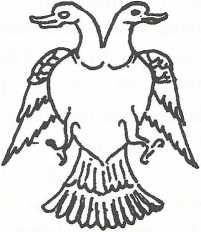Gaṇḍabheruṇḍa
From Hindupedia, the Hindu Encyclopedia
By Swami Harshananda
The Gaṇḍabheruṇḍa, a double-headed eagle, has been the State symbol of many royal dynasties especially in South India. Prominent among them are the emperors of Vijayanagara and the kings of Mysore. It still continuous to be the symbol of the Karnataka State.
According to the archaeologists and historians, the bird signifies peace, progress and power. The Purāṇas indicate that Viṣṇu as Gaṇḍabheruṇḍa subdued Śiva as Śarabhaas after Narasimha was conquered by Śarabha.[1]
Evidence of Gaṇḍabheruṇḍa throughout history[edit]
- The bird, Suparṇa, of the Ṛgveda might be an early edition of this bird
- The Gaṇḍabheruṇḍa symbol has been traced to the Indus Valley civilization at Mohenjo Dāro
- The symbol has also been found at Takṣaśilā (Taxila).
- The well-known folk-tale poem, the Pañcatantra, mentions this bird in one of its tales.
- In the village Balligāve in the Shimoga district of Karnataka, there is a pillar of the Cālukyan era (A. D. 1047) depicting the deity Bheruṇḍeśvara[2] along with an edict.
References[edit]
- The Concise Encyclopedia of Hinduism, Swami Harshananda, Ram Krishna Math, Bangalore

